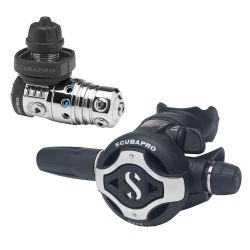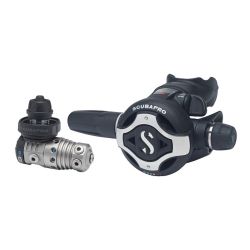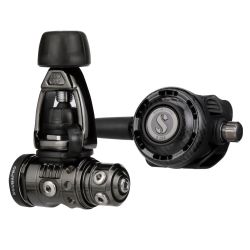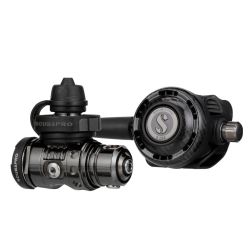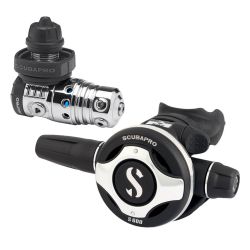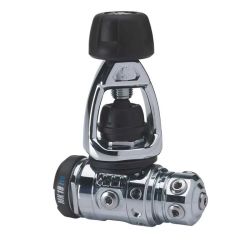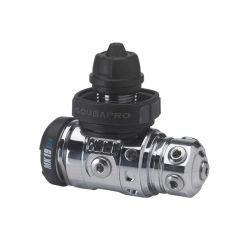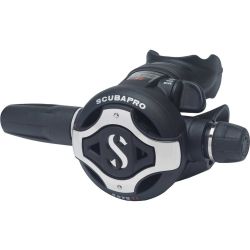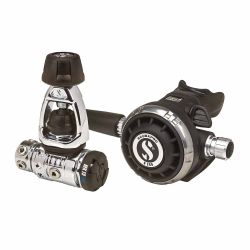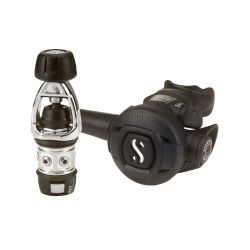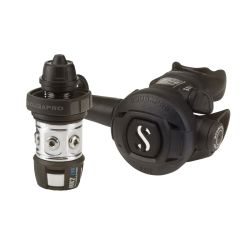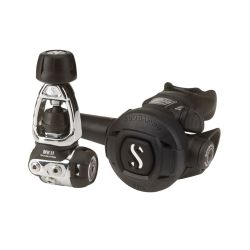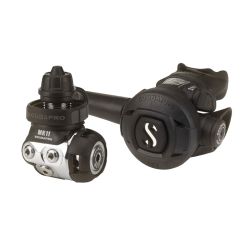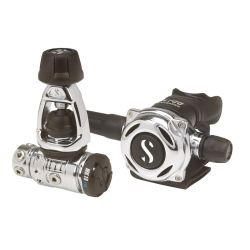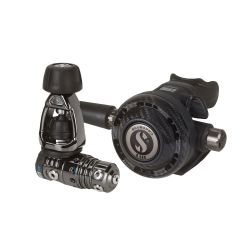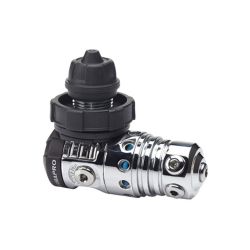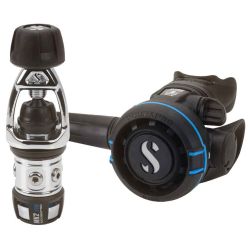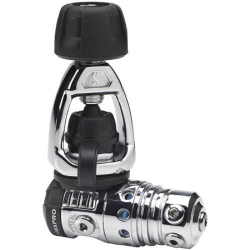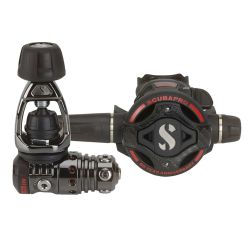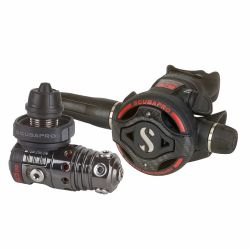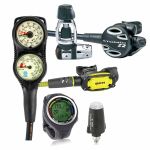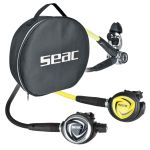We use cookies to enhance your experience on our website. By clicking “I Agree,” you consent to our use of cookies in accordance with our Privacy Policy. If you choose not to allow cookies on our website, some of the website’s functions may not be available to you. Learn more.
Scuba Regulators
The scuba regulator is your life-support scuba gear when you dive. It’s what lets you breathe air when you are deep in the water. A diving regulator transforms the pressurized air in the tank into breathable air. That’s how you get to enjoy your atomic aquatics expedition without interruption!
How Do Scuba Regulators Work?
A scuba diving regulator operates on a simple yet effective principle. It reduces the high pressure of the air stored in the scuba tank to ambient pressure in two stages:
- The first stage of the regulator attaches directly to the tank. It reduces the air pressure from the tank (which can be up to 3000 psi or more) to an intermediate pressure (generally around 140 psi above ambient water pressure).
- The second stage, which the diver places in their mouth underwater, reduces this intermediate pressure to ambient pressure. It delivers breathable air to the diver only on demand, which means air is supplied when the diver inhales and stops when they exhale. The second stage is often called a demand valve because the diver uses it when they need air to breathe.
What Is a Scuba Regulator Made of?
Let’s look at scuba diving regulators' standard components to get a clear picture of what’s included in this amazing piece of diving equipment.
First and second stages
We mentioned above the two stages of the regulator. The core of the regulator system, where the first stage reduces high-pressure tank air to an intermediate pressure, and the second stage delivers it to ambient pressure for the diver to breathe.
Adjustable airflow
Many regulators offer a way to adjust the airflow in the second stage. This helps divers fine-tune breathing resistance to their comfort level.
Purge button
The purge button is located on the second stage and allows divers to manually clear the regulator of water or debris.
Balanced vs. unbalanced system
Balanced or unbalanced? Regulators are often balanced, which means they provide consistent airflow regardless of the tank pressure or depth. Breathing becomes more difficult as you dive deeper but a balanced regulator will fine-tune your breathing and adjust to the increased pressure.
Environmental sealing
To prevent freezing and contamination by sand, salt, etc., the first stage is often environmentally sealed for better performance in cold water and to lower your gear’s maintenance needs.
Alternate air source
Regulators typically have multiple low-pressure and high-pressure ports in the first stage. Low-pressure ports are used for connecting a secondary air source. This is a safety precaution in case a fellow diver needs air or if your own mouthpiece is malfunctioning.
Mouthpiece comfort
The mouthpiece in a scuba regulator should be well-designed to reduce jaw fatigue. The aim is for the diver to hold the second stage in their mouth for extended periods without noticing.
Material and construction
Scuba regulators are made from durable materials like marine-grade brass, stainless steel, and lightweight composites. They have been designed to withstand the rigors of saltwater and pressure changes.
How Do I Choose the Best Regulator for My Diving?
With over 300 of the best scuba regulators available to shop on our Divers Supply site, we understand you might feel overwhelmed. Let’s make things easier and simpler for you.
Diving conditions
Consider where you plan to dive.
If you dive in cold water, look for a dive regulator that is environmentally sealed. For diving in warm tropical waters, you might prefer a lightweight and compact design.
Breathing comfort
You want a regulator that’s easy and comfortable to breathe through, at various depths. You can look for reviews or test them in a diving pool if possible, to see how they perform under pressure and how easy it is to breathe from them.
Adjustability
Some regulators allow you to adjust the breathing effort required. This feature is practical if you want to customize the airflow based on your diving activity.
Durability and maintenance
Durable materials like brass and titanium are more resistant to corrosion and wear. Also, check how often the regulator needs servicing and the availability of service centers or parts in your area.
Features and extras
Look for additional high-performance regulator features that may be useful for your diving style, such as high-pressure ports that connect to gauges, dive computers to monitor tank pressure, whether it includes a swivel joint to reduce jaw fatigue, or the number of low and high-pressure ports, which will determine how many accessories you can connect.
Shop Now
Are you interested in scuba regulators? Contact us today to find the ideal system for you with our best price guarantee and free shipping for orders over $25!
Frequently Asked Questions
What is the difference between a piston and a diaphragm first-stage regulator?
Piston regulators are typically simpler, with fewer moving parts, They thus offer greater reliability and easier maintenance.
Diaphragm regulators are often considered more environmentally sealed and better suited for cold water or murky conditions as they prevent water and contaminants from reaching the first stage.
How can I adjust the breathing effort on my regulator?
Many modern regulators have a knob or lever on the second stage that helps divers adjust the breathing effort. Turn the adjustment to make breathing easier or harder, depending on your preference and the diving conditions.
Is it necessary to have a dive computer integrated with my regulator?
It’s not necessary but it’s practical and convenient. When you integrate the two, you can streamline dive data and monitor dive information like depth, dive time, and tank pressure directly on a display connected to your regulator.
Can I use my scuba regulator in both fresh and saltwater?
Yes, scuba regulators are designed to function in both fresh and salt water. Always rinse thoroughly the regulator with fresh water after diving in salt water to prevent corrosion and salt crystal formation.
One of the most important pieces of equipment used in scuba diving is the scuba regulator. Scuba regulators allow the diver to breath the air from their tank at a lower pressure level. Need more info? Check out our Regulator Buying Guide.
Need to get your Regulator Serviced?
Looking for a Regulator Hose?







